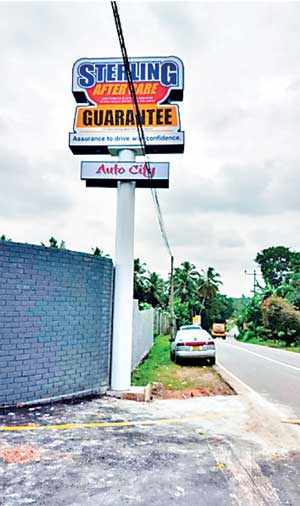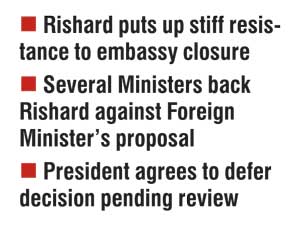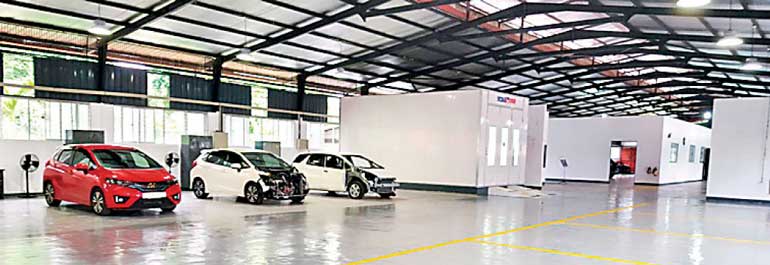Thursday Mar 06, 2025
Thursday Mar 06, 2025
Monday, 4 January 2016 00:00 - - {{hitsCtrl.values.hits}}

Sri Lankan President Maithripala Sirisena and Pakistan Prime Minister Nawaz Sharif

Sri Lankan President Maithripala Sirisena and Pakistan President Mamnoon Hussain
At a time of the visit of the Prime Minister of Pakistan, Nawaz Sharif, to Sri Lanka it may be useful to have a preliminary look at the progress of the Pakistan-Sri Lanka Free Trade Agreement (PSLFTA) which has now functioned for a decade, from 2005-2015.
Signed in 2002 and coming into operation in 2005, the Agreement was the first bilateral free trade agreement (FTA) of Pakistan and the second bilateral FTA of Sri Lanka. The basic line of thinking behind the FTA was that the existing strong political and social relations between the two countries should be strengthened with stronger economic ties. Thus both countries agreed to subject freer movement of goods between the two countries via preferential tariffs in an FTA.
Just like in the India-Sri Lanka FTA, the asymmetry between the two countries was accommodated by Pakistan by offering Special and Differential Treatment (SDT) in favour of Sri Lanka. SDT manifested in: (a) Pakistan offering 206 products duty free entry for Sri Lanka immediately after the FTA became operational in 2005 compared to 102 products by Sri Lanka; (b) offering alarger negative list of 697 products to Sri Lanka compared to 540 products to Pakistan; (c) five year tariff phasing out period (till 2010) given to Sri Lanka compared to three years for Pakistan (till 2008), etc.

All products covered by the Agreement were eligible for preferential treatment if they satisfied the Rules of Origin (ROO) as defined in the Agreement. The aggregate value addition for ROO was set at 35% of the FOB value, however, if inputs from the importing country are utilised, minimum value addition was reduced to 25%. A unique feature of the FTA is that the Change of Tariff Heading (CTH) was set at 6 digit HS classification, which made product categorisation much easier. Details pertaining to the regulatory framework governing the FTA can be easily viewed in the Department of Commerce website (http://www.doc.gov.lk/web/).
Outcome
If we take one year before the FTA came into operation, i.e., 2004 and ten years after that, i.e. 2014 as comparing years we observe the following. In 2004, Sri Lankan exports to Pakistan amounted to $46 million and it increased to $74 million in 2014, recording an average growth rate of 11% and amounting close to 0.8% of Sri Lankan total exports to the world in both years.
Pakistan’s exports to Sri Lanka amounted to $135 million in 2004 and $280 million in 2014, recording an average growth rate of 15% and amounted close to an average of 1.7% of Pakistan’s total exports to the world.
As Figure 1 shows, Pakistan’s exports to Sri Lanka have grown faster than Sri Lankan exports to Pakistan during the last decade, thus widening the trade deficit between the two countries. This is to be expected when trading with a larger country even with SDT in the FTA. As has been argued in trade literature, what matters is not the deficit but working out a ‘win-win’ outcome for both countries.
 Sri Lankan Exports to Pakistan
Sri Lankan Exports to Pakistan
Sri Lanka’s main exports to Pakistan are: vegetable products, fibre boards, rubber products, textile and clothing, desiccated coconuts, and lentils (Figure 2). The top 10 Sri Lankan exports to Pakistan account for over 70% of Sri Lanka’s total exports to Pakistan, indicating that Sri Lankan exports to Pakistan are concentrated in a narrow range of goods. While the FTA covers almost 80% of Sri Lanka’s exports to the world, it excludes some vital exports of Sri Lanka – tea, textiles and apparel, rubber products, paper products, footwear, ceramics, etc. These items are in Pakistan’s negative list with tea under Tariff Rate Quota (TRQ) of 10,000 MT duty free and apparel under TRQ of 3 million pieces at 35% margin of preference.
Nevertheless, Sri Lanka’s tea exports have declined over time from 2000 tonnes in 2003 to 500 tonnes by 2013. This decline is mainly attributed to consumer preference for CTC teas, relatively high price of Ceylon tea and competition from other tea exporting countries like Kenya. Sri Lanka has not made full use of the apparel quota also perhaps due to the low margin of preference.
The PSLFTA has not contributed significantly to diversifying the Sri Lankan export basket to Pakistan. The new products that had benefited from the PSLFTA preferential tariffs are: fresh pineapples, sports goods, tamarind with seeds, and activated carbon.
Other new Sri Lankan exports that have penetrated the Pakistani market are edible oil, porcelain tableware and kitchenware, ceramic tiles, furniture, electrical switches and sockets, herbal cosmetic products, plastic articles, paints, glass paintings, leather products, frozen fish, prawns, lobsters, crabs, cut flowers and foliage, gems and jewellery and aquarium fish.
Data shows that Sri Lanka exports only 32 items out of 156 items under the FTA. This clearly shows that a large market remains unexploited.
Pakistan’s Exports to Sri Lanka
Pakistan’s major exports to Sri Lanka are: cotton, cement, cereals, sugar, edible vegetables, pharmaceutical products, and iron and steel. The top 10 exports of Pakistan to Sri Lanka account for over 70% of Pakistan’s total exports to Sri Lanka and this concentration has been prevalent even before the FTA. Pakistan’s exports to Sri Lanka amounted to 1.26% of Pakistan’s overall exports in 2013. The share of Pakistan’s exports to Sri Lanka fluctuated between 1.4-2.1% of Sri Lankan overall imports during the last decade.
The items in the Sri Lankan negative list are: bulk of the agriculture sector, rubber products, paper products, ceramic products, metal products, footwear, motor vehicles and parts. The motor vehicles and parts were kept in the negative list due to revenue reasons. Both Basmathi rice and potato exports of Pakistan are under TRQ in Sri Lanka.
Sri Lanka imports apples, apricots, dates and other fruits at much higher prices from US and the Middle East. In fact, these products can be imported from Pakistan at a cheaper price if not for the prevailing Export Quotas for these products in Pakistan.
Key Issues
The overall picture is that trade between the two countries has shown lacklustre growth despite the FTA. Both countries have a limited basket of goods to export to each other. Trade has continued in roughly the same mix of products that existed prior to the FTA and most tariff lines continue to report zero trade. This is in contrast to Sri Lanka’s trade with India and China where significant and rapid growth has occurred.
A recent study shows that the fledging trade links cannot be blamed on a paucity of opportunities or lack of potential for trade (The Pakistan Business Council, April 2015). Although a Ministerial Review meeting of the PSLFTA took place in 2008 and 2014 and the Pakistan-Sri Lanka Joint Commission had agreed to activate four joint Working Groups (on Trade, Investment, Auto Sector, and Customs Cooperation) to strengthen cooperation, a major impediment is the limited interaction of the businessmen of the two countries. Neither country views the other as a priority market despite many opportunities. This is clearly indicated by lack of regular trade delegations and single country exhibitions which normally leads to strengthening business ties between two countries.
Since there is limited trade between the two countries, non-tariff barriers (NTBs) have not emerged as a major problem among the complaints of the businessmen of both countries. The specific problems that have emerged are: (a) charges on tariffs and imposing para tariffs from time to time by both countries without adequate notification by both countries – these undermine the spirit of the FTA and disrupt business dealings between the two countries; (b) lack of a dispute settlement mechanism or a forum for arbitration of trade disputes. Consequently, delayed resolution or lack of resolution of trade disputes has acted as a disincentive to trade between the two countries.
Bilateral trade between the two countries stands close to $400 million. In January 2014, both countries agreed to drive this trade to reach $1billion in the next two to three years. At this juncture, the target seems beyond reach, but if both countries make a concerted effort to expand trade it can be a reality soon.
(The writer is the Executive Director of the Institute of Policy Studies of
Sri Lanka)
Discover Kapruka, the leading online shopping platform in Sri Lanka, where you can conveniently send Gifts and Flowers to your loved ones for any event including Valentine ’s Day. Explore a wide range of popular Shopping Categories on Kapruka, including Toys, Groceries, Electronics, Birthday Cakes, Fruits, Chocolates, Flower Bouquets, Clothing, Watches, Lingerie, Gift Sets and Jewellery. Also if you’re interested in selling with Kapruka, Partner Central by Kapruka is the best solution to start with. Moreover, through Kapruka Global Shop, you can also enjoy the convenience of purchasing products from renowned platforms like Amazon and eBay and have them delivered to Sri Lanka.
Discover Kapruka, the leading online shopping platform in Sri Lanka, where you can conveniently send Gifts and Flowers to your loved ones for any event including Valentine ’s Day. Explore a wide range of popular Shopping Categories on Kapruka, including Toys, Groceries, Electronics, Birthday Cakes, Fruits, Chocolates, Flower Bouquets, Clothing, Watches, Lingerie, Gift Sets and Jewellery. Also if you’re interested in selling with Kapruka, Partner Central by Kapruka is the best solution to start with. Moreover, through Kapruka Global Shop, you can also enjoy the convenience of purchasing products from renowned platforms like Amazon and eBay and have them delivered to Sri Lanka.